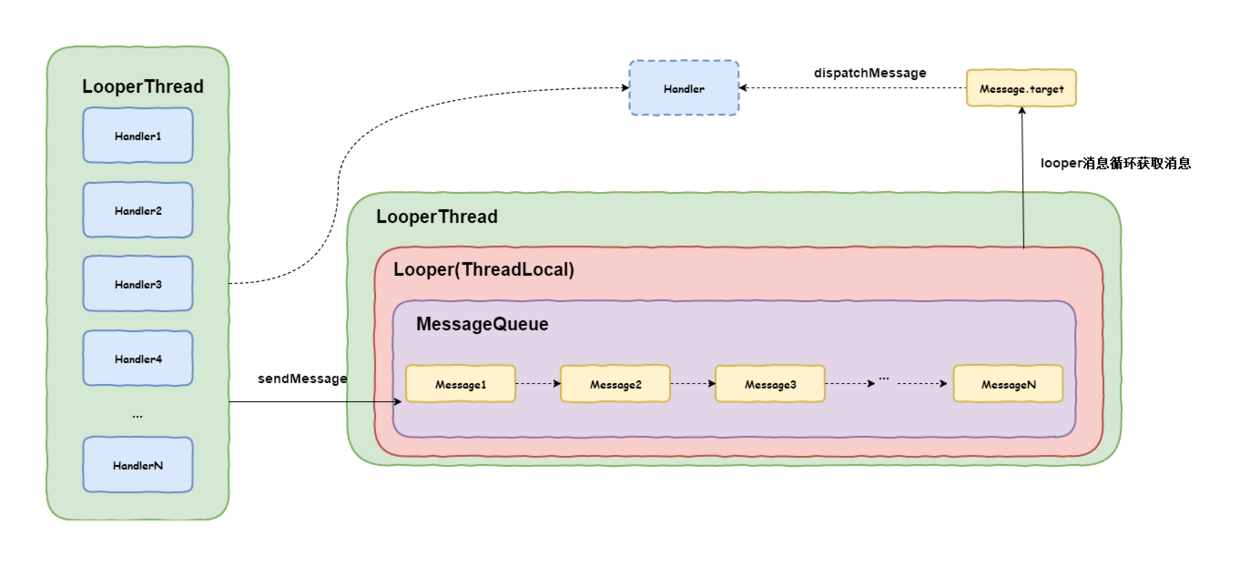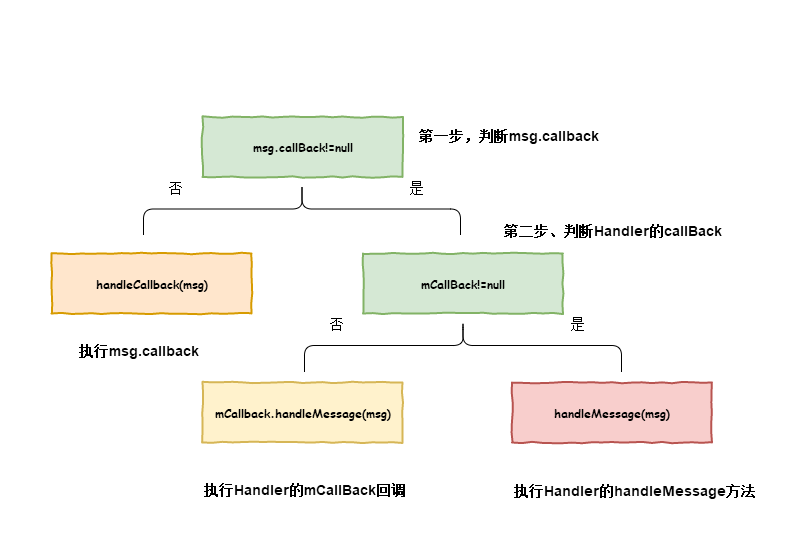
该文章属于Android Handler系列文章,如果想了解更多,请点击Android Handler机制之总目录
前言
上篇文章,我们讲了ThreadLocal,了解了线程本地变量的实质,如果有小伙伴还是不熟悉ThreadLocal原理的,请参看上篇文章Android Handler机制之ThreadLocal,如果你已经阅读 了该文章,那现在我们就一起来了解Handler与MessageQueue与Looper三者之间的关系及其内部原理。
Handler、MessageQueue、Looper三者之间的关系
在了解其三者关系之前,我先给大家一个全局的关系图,接下来的文章会根据该关系图,进行相应的补充与描述。
从上图中我们可以看出几点:
- Handler的创建是与Looper创建的线程是相同的。
- Looper中内部维护了一个MessageQueue(也就是消息队列)。且该队列是通过链表的形式实现的。
- Hanlder最终通过sendMessage方法将消息发送到Looper中对应的MessageQueue中。
- Looper通过消息循环获取消息后,会调用对应的消息中的target(target对应的是发消息的Handler)的dispatchMessage()方法来处理消息。
Looper原理
因为消息队列(MessageQueue的创建是在Looper中内部创建的,同时Handler消息的发送与处理都是围绕着Looper来进行的,所以我们首先来讲Looper。
Looper是如何与主线程关联的
在平时开发中,我们使用Handler主要是为了在主线程中去更新UI,那么Looper是如何与主线程进行关联的呢?在Android中,App进程是由Zygote fork 而创建的,而我们的ActivityThread就是运行在该进程下的主线程中,那么在ActivityThread的main方法中,Looper会通过prepareMainLooper()来创建内部的消息队列(MessageQueue),同时会通过loop()构建消息循环。具体代码如下图所示:
1 | public static void main(String[] args) { |
要了解当前Loooper如何与主线程进行关联的,需要继续查看prepareMainLooper()方法。下述代码中,为了大家方便,我将prepareMainLooper()方法所涉及到的方法全部罗列了出来。
1 | //创建主线程Looper对象 |
观察上诉代码,我们发现,prepareMainLooper方法内部调用prepare()方法(这里我们忽略该方法中的参数 quitAllowed),而prepare内部调用的是ThreadLocal的set()方法。如果你阅读了之前我写的Android Handler机制之ThreadLocal,那么大家应该知道了当前Looper对象已经与主线程关联了(也可以说,当前主线程中保存了当前Looper对象的引用)。
Looper内部创建消息队列
在了解了Looper对象怎么与当前线程关联的后,我们来看看Looper类中的具体方法。之前我们说过,在创建Looper对象的时候,当前Looper对象内部也会创建与之关联的消息队列(MessageQueue)。那么查看Looper对应的构造函数:
1 | final MessageQueue mQueue; |
从Looper对象的构造函数中,我们很明显的看出内部创建了MessageQueue对象,也验证了我们之前的说法。
Looper的消息循环
当前Looper对象与主线程关联后,接着会调用Looper对象中的loop()方法来开启消息循环。具体代码如下图所示:
1 | public static void loop() { |
通过上述代码,我们可以看出,在Looper中的loop()方法中会一直去拿当前消息队列中的消息,如果能取出消息会调用该消息的target去执行dispatchMessage()方法。如果没有消息,就直接退出消息循环。
MessageQueue原理
MessageQueue的next()方法
因为Looper中loop()方法会循环调用MessageQueue中的next方法,接下来带着大家一起查看该方法。代码如下图所示:
1 | Message next() { |
上述代码中,我省略了很多代码,现在大家不需要关心省略的内容,大家只要关心大的一个方向就够了,关于MessageQueue的next()具体详解,会在下篇文章Handler机制之Message的发送与取出” 具体介绍。好了,大家把状态调整过来。
在上文中,我们说过MessageQueue是以链表的形式来存储消息的,从next()方法中我们能分析出来,next()方法会一直从MessageQueue中去获取消息,直到获取消息后才会退出。
MessageQueue的enqueueMessage()方法
通过上文,我们已经了解Message取消息的流程,现在我们来看看消息队列的加入过程。
1 | boolean enqueueMessage(Message msg, long when) { |
上诉代码中,我们把重心放在for循环中,在for循环中主要干了 一件事,就是根据当前meesag.when的值,来确定当前插入的消息应该放入消息队列的位置。(当前小伙伴肯能会对message.when感到困惑,还是那句话,现阶段我们只用关心主要的流程,具体的方法详解会在下篇文章 Handler机制之Message的发送与取出”具体介绍。
Handler的原理
了解了Looper与MessageQueue的原理后,我们大致了解了整个消息处理的关系,现在就剩下发消息与处理消息的流程了。最后一点了,大家坚持看完。
Handler是怎么与Looper进行关联的
在文章最开始的图中,Handler发消息最终会发送到对应的Looper下的MessageQueue中。那么也就是说Handler与Looper之间必然有关联。那么它是怎么与Looper进行关联的呢?查看Handler的构造函数:
1 | //不带Looper的构造函数 |
在Handler的构造函数中,主要分为两种类型的构造函数,一种是带Looper参数的构造函数,一种是不带Looper参数的构造函数。
- 在不带Looper参数的构造函数中,是通过Looper.myLooper()来获取当前Looper对象的(也就是说,Handler获取的Looper对象是与当前实例化当前Handler的线程相关的,那么如果Handler对象是在主线程中创建的,那么获取的就是主线程的Looper,注意前提条件当前线程线程已经通过Looper.prepare()与Looper.loop()构建了循环消息队列,因为只有调用了该方法后,才会将当前Looper对象放入线程的局部变量中)
- 在带Looper参数的构造函数中,Looper对象是通过外部直接传入的。(这里其实给我们提供了一个思路,也就是我们可以构建自己的消息处理循环,具体细节参看类HandlerThread)
Handler怎么将消息发送到MessaageQueue(消息队列)中去
在了解Handler怎么将消息发送到MessageQueue(消息队列),我们先来了解Handler的发消息的系列方法。
1 | //发送及时消息 |
在Handler发消息的方法中,我们可以总共发消息的种类,分为三种情况,第一种是及时消息,第二种是发送延时消息,第三种是定时消息。其中关于消息怎么在消息队列中排列与处理。具体的方法详解会在下篇文章 Handler机制之Message的发送与取出”具体介绍。
通过查看Handler发送消息的几个方法。我们发现内部都调用了MessageQueue的enqueueMessage()方法。
1 | private boolean enqueueMessage(MessageQueue queue, Message msg, long uptimeMillis) { |
该方法内部其实很简单,就是获取当前MessageQueue对象,将消息将入消息队列中去了。其中需要大家需要的注意的是这段代码msg.target = this。该代码意思就是当前的消息保存着当前发送消息的Handler对象的应用。该行代码非常重要。因为最后涉及到消息的处理。
Handler怎么处理消息
通过上文的描述,现在我们已经大致了解Handler是怎么将消息加入到消息队列中去了,现在需要关心的是当前消息是怎么被处理的。大家还记的之前我们讲过的Looper原理吧,Looper会调用loop()方法循环的取消息。当取出消息后会调用message.target.dispatchMessage(Message msg)方法。其中message.target从上文我们已经知道了,就是当前发送消息的Handler。那么最终也就会回到Handler中的dispatchMessage()方法。
1 | public void dispatchMessage(Message msg) { |
观察该方法,我们可以得出,Handler中的dispatchMessage()方法主要处理了三个步骤,下面分别对这三个步骤进行讲解
第一步,执行message.callback
在Handler中的dispatchMessage()方法中,我们已经知道如果msg.callback != null,那么我们会直接走handleCallback(msg)方法。在了解该方法之前,首先我们要知道msg.callback对于的类是什么。这里我就直接给大家列出来了。其实msg.callback对应是以下四个方法的Runnable对象。
1 | public final boolean post(Runnable r) |
以上四个方法在发送Runnable对象时,都会调用getPostMessage(Runnable r) 方法,且该方法都会将Runnable封装在Message对象的callback属性上。具体如下getPostMessage(Runnable r) 方法所示:
1 | private static Message getPostMessage(Runnable r) { |
在了解了Message的callback到底什么过后,我们再来看看handleCallback(Message message)方法
1 | private static void handleCallback(Message message) { |
该方法其实很简单,就是调用相应Runnable的run()方法。
第二步,执行Handler的callBack
如果当前Message.callback为空,接下来会判断Handler中的Callback回调是否为空,如果不为空则执行Callback的handleMessage(Message msg)方法。Callback的具体声明如下:
1 | //避免创建Handler对象重新HandlerMessage方法,你可以直接传入Callback接口实现 |
其中在Handler的几个构造函数中,可以传入相应Callback接口实现。
1 | public Handler(Callback callback) |
第三步,执行Handler的handleMessage)
如果都不满足上面描述的第一、第二情况时,会最终调用Handler的handleMessage(Message msg)方法。
1 | //Handler内部该方法是空实现,需要子类具体实现 |
为了方便大家记忆,我将Handler中的dispatchMessage()具体的逻辑流程画了出来。大家按需观看。

最后
看到最后大家已经发现该篇文章主要着重于将Handler机制的整个流程,对于很多的代码细节并没有过多的描述,特别是关于Looper从MessageQueue(消息队列)中取消息与MessageQueue(消息队列)怎么放入消息的具体细节。不用担心,关于这两个知识点将会在下篇文章 Handler机制之Message的发送与取出”具体描述。h